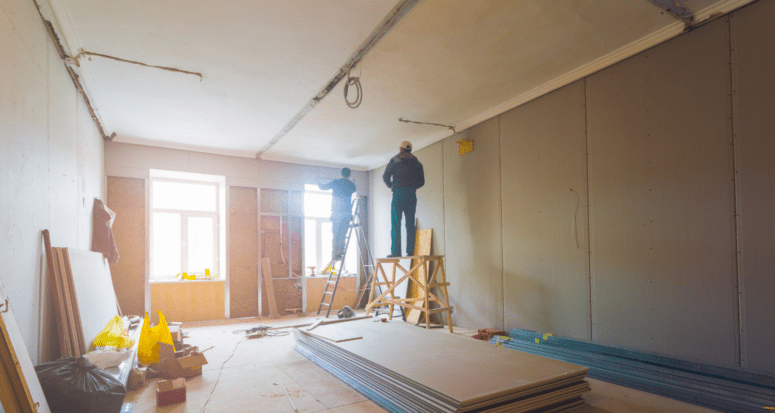Planning a Remodel? Know Your Home Renovation Loan Options
- Published on
- 7 min read
-
 Alesandra Dubin Contributing AuthorClose
Alesandra Dubin Contributing AuthorClose Alesandra Dubin Contributing Author
Alesandra Dubin Contributing AuthorAlesandra Dubin is a lifestyle journalist and content marketing writer based in Los Angeles. Her vertical specialties include real estate; travel; health and wellness; meetings and events; and parenting. Her work has appeared in Business Insider, Good Housekeeping, TODAY, E!, Parents, and countless other outlets. She holds a master's degree in journalism from NYU.
In 2020, the average American household spent $8,305 on home improvements — that’s almost the exact amount the average household has in their savings account, according to Bankrate’s recent analysis of data from the Federal Reserve.
But rather than draining their savings, most homeowners opt to finance their home home improvement with credit or a home renovation loan. A recent survey by Discover Home Equity Loans reveals that 23% of homeowners plan to pay for their renovation with a credit card, 18% with a home equity line of credit (HELOC), 13% with a home equity loan, and 7% with cash-out refinance.
If you’re considering taking out a home renovation loan to spruce up a powder room or gut the kitchen, we’ve got you covered. Our expert-backed primer unpacks the array of renovation loan options available today and how they impact your future home sale. We’ll also share tips on how to focus on remodeling projects that add value to your home to help you recoup your investment.

An overview of home renovation loan options
If you’re interested in taking out a home renovation loan, you’ve got options. Here’s an overview of the most common home renovation loans available:
Cash-out refinance
With this option, the borrower refinances their existing mortgage, and the lender advances an additional amount in cash for the renovation project. Typically, lenders will allow homeowners to refinance 80% to 90% of the property’s value.
You might consider this option if you have at least 20% equity in the property and a strong credit score, plus can secure an interest rate lower than your current one. A major upside with a cash-out refinance is that it’s a standard first mortgage loan, not a secondary lien or line of credit.
Construction loan
Homeowners can use a construction loan to cover land, building labor and materials, permitting, and other relevant expenses for residential properties. These are short-term loans (usually about a year) with higher interest rates. To qualify for a construction loan, you’ll need to provide the lender the detailed project plans, background on the licensed contractor managing the project, at least 20% equity in your home, and proof of your ability to repay the loan (proof of income and good credit history).
Owner-builder construction loan
If you plan to build your own home, an owner-builder loan is the loan for you. Lenders see these borrowers as higher risk (their projects can take longer and encounter more problems), so these loans may be harder to qualify for. You’ll need to demonstrate a detailed construction plan with costs to show you’re competent to complete the job.
While these loans come with a higher interest rate, you can recoup the cost if your completed project adds value to your home; plus, you’ll likely make up for the higher interest with your savings from forgoing a contractor.
Home equity loan and HELOC
Home equity financing enables homeowners with equity to access cash from their homes for renovations (or other needs). Typically, these types of loans that allow you to tap into your equity require a second lien (or “second mortgage”) in addition to your existing mortgage. Since these loans are secured against your equity in the house, lenders might offer lower rates than they would for a personal loan.
A regular home equity loan works very similarly to your standard mortgage. The money borrowed against the equity in your home comes as a one-time, lump sum and typically with a fixed interest rate. You’ll typically need at least 10% equity in your primary home or 20% for an investment property to qualify.
A HELOC — short for “home equity line of credit” — is a revolving line of credit that you can draw from as needed, sort of like a credit card. With a HELOC, you’ll be approved for a line of credit equal to your maximum draw amount, but it’s not paid as a lump sum. Instead you will be able to withdraw money from the account as you need it, much like a credit card, but this debt is secured by our home. The upside to HELOCs is their flexibility in using the funds how and when you want, and the fact that you only need to pay interest on the money you’ve drawn from the account. Plus, HELOCs may have a few unique tax advantages for the savvy homeowner.
Government loans
Why would the government want to help fund your remodeling project? Well, because when property values rise, the community and local economy benefit, as well. So the government offers low-interest loans with tax relief benefits and other incentives to encourage homeowners to improve their homes.
But don’t expect Uncle Sam to back your dream of building a super custom Star Trek basement. To qualify, you must prove that you will use the loan on a project proven to appreciate your home’s value. Here’s an overview of the two most common government home renovation loans:
- FHA 203(k) Rehabilitation Loans allow homeowners to take out a single loan for both their home renovation and home purchase or refinance. Since these loans are insured by the government, lenders can offer them with relatively low-interest rates.
- Home improvement programs (HIPs) help homeowners save on their remodeling loans with subsidized interest (either partly subsidized or entirely subsidized, depending on the application).
Personal loan
You can qualify for a personal loan even if you don’t need to have equity in your home. Your loan’s term and interest rate will largely depend on your creditworthiness. However, since personal loans are higher risk for lenders, these loans often have higher interest rates than other home renovation loan options.

Review your finances and future plans before you borrow
Regardless of the loan type, renovation loans are debt that you’ll need to pay back over time. Carefully review your finances and discuss your options with your lender to ensure that taking out a home renovation loan is the right move for you.
Evaluate your equity before you borrow
In the early stages of planning your home renovation, check your home equity. If your equity is low or in the negative range, you’re probably better off saving money to pay for the renovation in cash than taking on more debt, even if the upgrade will add value to your home.
Consider your future home sale plans
When evaluating if you should take out a loan to renovate, you should also consider how soon you plan to sell. If your remodeling project won’t significantly increase your home’s value or marketability, it might not be worth the effort. Ask your real estate agent and lender if they recommend going through with the renovation before you develop your project plans.
“It comes down to getting the right team. If you have the right team around, you’re really getting the best advice from the right people at the right time,” shares top real estate agent Mark Pages-Oliver, who closes 8% more sales than the average agent in Concord, CA.
When the demolition dust clears, you’ll owe the backing lender
Remember that you’ll need to pay back the principal and accrued interest for the duration of established loan term. To keep your total investment down, you’ll most likely want to choose the loan with the lowest interest rate. Let’s take a look at how interest differs between unsecured and secured loans.
Unsecured loans tend to have higher interest rates
Government loans, personal loans, construction loans, and construction-builder loans are unsecured debt, meaning that the debt is not backed by collateral (your home). Since the lender has no claim to your home to recover their investment if you default on payments, these loans typically have a higher interest rate than secured loans.
If you default on your payments, your lender will report the late payment to the credit bureaus. Once reported, these late payments lower your credit score and appear on your credit report for a length of time — ultimately making it difficult for you to qualify for new credit.
Secured loans are liens on your property
If you finance your home renovation with cash-out refinance or a home equity line of credit (HELOC), the loan will serve as a lien on your property that you must resolve to clear title. In other words, the lender has a claim to your home if you default on payments. Since the lender has collateral, these loans typically have lower interest rates than unsecured loans such as a personal loan or credit card.
However, you’ll need to pay off the loan when you sell your home to clear title for the new homeowners. If you’re selling right away, the escrow company will help you understand and manage these responsibilities.
“When we go to sell the property, we appoint an escrow company, and part of their responsibility is to understand all of the liens on the property, who needs to be paid off, and in what order,” Pages-Oliver explains. “So then when it comes to closing, the sellers will get an itemized list of all of the expenses, which will include the lien holders and the totals that they need to be paid out.”
The escrow company will calculate the exact amount “down to the penny” that the seller owes to all of these lien holders, including any and all pay-off fees that might be associated. The escrow company will present the total to the seller prior to the close of escrow so that they understand what they’ll net from their home sale after paying off all their loans, pro-rata property taxes, insurance, and closing costs.
Refinancing is an option to consolidate your debt
If you’re selling down the road, you may consider refinancing your home to consolidate debt on the property and, in some cases, to secure a lower interest rate. These decisions will be highly individual and specific to the seller’s situation.
“We often see that people will get access to borrowed funds in one particular mechanism, and once they’ve completed that, the situation changes,” Pages-Oliver says.
“Part of the overall lending strategy would be to look at whether consolidation is worthwhile. If that’s the best solution for our client, then that’s something that they really should know about and understand.”
What it comes down to is the bigger goal, or “the master objective,” as Pages-Oliver calls it:
“What is going to serve the client best moving forward? Sometimes that might be keeping two separate liens on the property; sometimes, it might be consolidating. But every situation is always slightly different, and that’s what we need to get expert advice.”

Focus on value-adding and value-retaining home improvements
If you decide to take out a home renovation loan, you should focus on projects that either add value to your home or help your home retain value.
“The things that retain value are important to the property but aren’t necessarily show stoppers,” he says. “They’re not going to show up in the photos necessarily. They’re not going to draw crowds of people through the property, but they’re really important to have in some marketplaces.”
Examples of these value-retaining home improvements include sewer pipe upgrades and roof replacement. On the other end of the spectrum, some cosmetic improvements are unlikely to recoup much or any of their costs — especially those with highly custom or unusual finishes.
According to Remodeling Magazine’s 2020 Cost vs. Value Report, the following projects are your safest bet for hitting a remodeling home run:
- A minor, mid-range kitchen remodel recoups around 78% of the project cost on average.
- With a roof replacement, sellers recoup about two-thirds of the project cost on average.
- A primary bathroom remodel also recoups about two-thirds of a seller’s project investment.
- Other notable remodeling projects topping the list include garage door replacements and stone veneer replacements, for which sellers tend to recapture nearly the entire cost when they go to sell.
When in doubt, Pages-Oliver advises sellers to “follow the staging formula”:
“If we follow that formula, kitchens and bathrooms are really at the top of the agenda for buyers, and that’s where we should be concentrating money.”
The best renovation loans for you depends on your unique situation
When evaluating home renovation loans, remember to consult your real estate agent and lender for guidance.
“Everyone is different, everyone’s circumstances are different, and everyone’s goals are different — there really is no one-size-fits-all approach,” Pages-Oliver notes. “When it comes to lending for renovations, it really does need to be a bespoke solution that takes into account a lot of factors about the circumstances.”
Header Image Source: (Zakhar Mar / Shutterstock)
